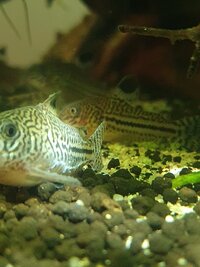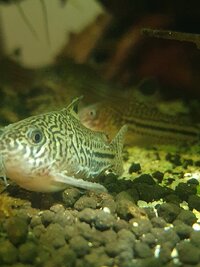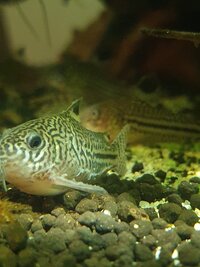DTM61
Member
Hi all,
I've had six of these Corys for about a year now, all super fat and breeding. I've actually had four fry survive to adulthood in this tank with no input from myself. Unfortunately all the youngsters perished within the last week and a half. Furry growths, extra slime, the odd shiny scale I'm guessing was lifted, lethargy. They all fought well and had an appetite until the end. All had previously had a course of praziquantel.
I finished a five day course of esha exit and 2000 a couple of days ago and have done a couple of big water changes however I've just noticed a full blown infection on one of the adults. Unfortunately she's moving little and breathing faster than the rest. I can see a halo of something all over her (see pic - particularly obvious towards tail end), dots around her head, pronounced edge where side meets belly and a shiney scale. Camera shows more than I can actually see in person.
The only thing I've changed was to add two peace lilies wc 25.4 22. Roots were washed and no chemicals used. Never heard about anything related before?
Any help in diagnosis would be very much appreciated. I have imidiate access to esha exit, 2000 and flukesolve (praziquantel?) but will try anything. Only other fish are honey gourami. FTS and patient shot attached.
Thanks
Dan


I've had six of these Corys for about a year now, all super fat and breeding. I've actually had four fry survive to adulthood in this tank with no input from myself. Unfortunately all the youngsters perished within the last week and a half. Furry growths, extra slime, the odd shiny scale I'm guessing was lifted, lethargy. They all fought well and had an appetite until the end. All had previously had a course of praziquantel.
I finished a five day course of esha exit and 2000 a couple of days ago and have done a couple of big water changes however I've just noticed a full blown infection on one of the adults. Unfortunately she's moving little and breathing faster than the rest. I can see a halo of something all over her (see pic - particularly obvious towards tail end), dots around her head, pronounced edge where side meets belly and a shiney scale. Camera shows more than I can actually see in person.
The only thing I've changed was to add two peace lilies wc 25.4 22. Roots were washed and no chemicals used. Never heard about anything related before?
Any help in diagnosis would be very much appreciated. I have imidiate access to esha exit, 2000 and flukesolve (praziquantel?) but will try anything. Only other fish are honey gourami. FTS and patient shot attached.
Thanks
Dan





